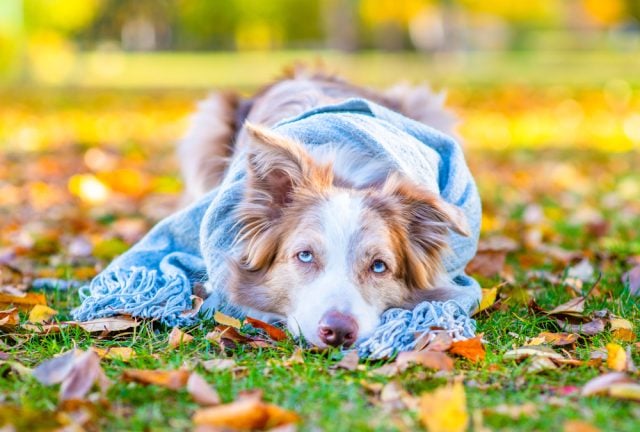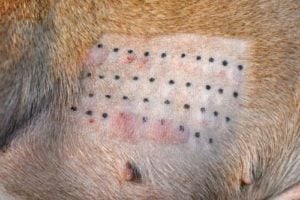
Table of Contents
Amber leaves, cooler temperatures, pumpkin spice in the air… only a few things we love about the fall season. But apart from the good stuff, it also comes with nasty ones—fall allergies in dogs.
Just like us, our dogs can also experience seasonal allergies triggered by pollen, mold, and environmental changes during autumn.
In this guide, we'll talk about the common symptoms, possible causes, treatments, and prevention tips for fall allergies in dogs.
RELATED: 8 Most Common Allergies In Dogs You Should Be Aware of
What Causes Fall Allergies in Dogs?
If your dog doesn't have known food allergies, chances are that environmental changes after summer are causing his sudden allergy.
The cooler temperatures and lower humidity may worsen skin dryness and irritation in dogs and humans, plus these common triggers:
Ragweed Pollen
Ragweed pollen is the most common allergen in autumn.
According to the Asthma and Allergy Foundation of America, almost 50 million people in the United States have symptoms from an allergy to ragweed pollen, and it's not far-fetched that it’s just as irritating for dogs.
This hardy weed releases pollen from late August through November.
 Mold spores
Mold spores
As leaves and grass decay, mold thrives in damp piles.
Molds can also affect dogs the same way they affect humans. If your dog loves rolling in the yard or exploring leaf piles, they will be more susceptible to the risks and dangerous effects of molds.
Dust mites
When the weather cools down, we close windows and turn on heating systems, creating the perfect environment for dust mites to multiply indoors.
The mites themselves produce allergens that trigger allergic reactions in both animals and humans.
Dogs with atopic dermatitis can be especially sensitive to dust mites.
 Other Indoor Allergens
Other Indoor Allergens
Things like fabric fibers, pet dander, and air filters clogged with dust can make matters worse as homes get less ventilation during colder months.
Make sure your carpets, bedding, and heating systems are cleaned regularly, because these can trigger fall allergies in dogs.
Dry air
Cooler temperatures and indoor heating can dry out your dog’s skin, leading to flakiness, itchiness, and irritation even without an allergic trigger.
In short, the same things that make fall cozy for humans (blankets, heat, and closed windows) can aggravate a dog’s sensitivities.
Signs and Symptoms of Fall Allergies in Dogs
The signs of fall allergies in dogs can vary depending on how sensitive they are and which allergens they’re reacting to.
However, most symptoms involve the skin, ears, and respiratory system.
These are the tell-tale signs that your dog may be suffering from fall allergies:
- Excessive scratching, licking, or chewing of paws
- Red, inflamed skin or ear infections
- Watery & puffy eyes or nasal discharge
- Sneezing or coughing
- Wheezing or Shortness of breath
- Hair loss or “hot spots”
- Digestive issues
- Head shaking (common with ear irritation)
- Restlessness or irritability due to discomfort
However, these are not foolproof indicators of seasonal allergy in dogs due to autumn.
Many of these symptoms mimic flea or food allergies in dogs, too, which is why a veterinarian should always confirm the diagnosis.
RELATED: 13 Most Common Signs of Allergies in Dogs
Diagnosing Fall Allergies in Dogs
Your veterinarian can help you determine what triggers your dog's allergic reactions, especially if they only occur in the fall season.
Diagnosis usually includes physical examination, allergy testing, and taking a closer look at your dogs' environment.
Your vet will perform a full physical exam and check for other possible causes like flea bites, skin infections, or parasites.
They’ll also ask about your dog’s environment and recent changes in grooming products or diet, if any.
Be prepared to ask questions about your dog's medical history (if it's your first time visiting), all the signs and symptoms you have observed, and the household products you have been using, among others.
 Your vet may also conduct a series of allergy tests on your dog, involving intradermal skin testing or blood tests to identify specific allergens.
Your vet may also conduct a series of allergy tests on your dog, involving intradermal skin testing or blood tests to identify specific allergens.
Allergy testing will also help tailor treatment plans to deal with your dog's allergy triggers.
Identifying triggers in your home or in the yard is also important, as these environmental factors are often the causes of fall allergies in dogs.
RELATED: Dog Elimination Diet: The Ultimate Science-based Guide
How to Treat Fall Allergies in Dogs
Unfortunately, there’s no “one-size-fits-all” cure for fall allergies, but with the right care plan, you can greatly reduce your dog’s discomfort.
 Medications and Veterinary Treatments
Medications and Veterinary Treatments
Ask your veterinarian about the safest and best medications you can give your dog based on the diagnosis.
It's important to work closely with the experts when giving these medications to your dog, as some of them can be extremely harmful when not administered properly.
- Antihistamines – Over-the-counter antihistamines like Benadryl (diphenhydramine) or Zyrtec (cetirizine) can help mild cases. Always consult your vet for dosage, as it varies by weight.
- Steroids or anti-inflammatories – For severe itching or inflammation, corticosteroids (like prednisone) may be prescribed for short-term relief.
- Allergy shots (immunotherapy) – These are custom injections that help your dog build resistance to specific allergens over time. This is a long-term solution with proven effectiveness.
- Medicated shampoos and sprays – Formulas containing oatmeal, aloe, or hydrocortisone soothe irritated skin and wash away allergens.
- Cytopoint or Apoquel – These are modern veterinary medications that block the itch signals in your dog’s body without the long-term side effects of steroids.
RELATED: 15 Safe Human Medications for Dogs
Natural and At-Home Remedies
If your dog's allergic reactions can be considered mild, there are remedies you can do at home to help ease their discomfort!
- Frequent baths: Wash your dog every 1–2 weeks with a gentle, hypoallergenic, or oatmeal shampoo. This removes pollen, dust, and mold spores from the skin.
- Wipe paws after walks: Use pet wipes or a damp towel to remove allergens before they’re tracked indoors or licked off.
- Regular grooming: Brushing helps remove loose fur, debris, and allergens trapped in the coat.
- Air purifiers and filters: HEPA filters help trap airborne particles like pollen and mold spores. Check these out: 5 Best Air Purifiers for Dog Hair
- Clean bedding and toys weekly: Wash with fragrance-free detergents to reduce allergen buildup.
- Hydration and diet: Provide fresh water and consider Omega-3 supplements (from fish oil or flaxseed) to improve the skin barrier and reduce inflammation.
You can also do these home remedies during the first few days of your dog's allergy symptoms.
However, if they persist beyond a week or worsen despite home care, it's best to reach out to your veterinarian immediately.
Untreated allergies can lead to secondary infections or chronic skin conditions that will be a lot harder to treat later on!
RELATED: How To Treat Dog Allergies At Home
Preventing Fall Allergies in Dogs
While we can't control the allergy triggers that come with the change in season, consistent home care can help us minimize our dog's and family's exposure.
Try the following:
- Keep windows closed during high-pollen days.
- Avoid outdoor walks when pollen peaks, usually later in the day.
- Clean air filters and humidifiers regularly.
- Vacuum carpets and upholstery weekly.
- Maintain your dog's healthy diet to boost immune defense.
FAQs About Fall Allergies in Dogs
Can dogs develop seasonal allergies later in life?
Yes, dogs can develop seasonal allergies at any age, even if they didn’t have symptoms before.
A dog's immune system changes over time, and repeated exposure to environmental triggers like pollen, mold, or dust can cause the sudden development of allergies.
How can I tell if my dog’s itching is from allergies or fleas?
Flea bites usually cause intense itching, but it's often only in one spot, mostly near the tail, and with visible flea dirt or bites.
Allergy-related itching is often more general and may come with red skin, ear infections, or paw licking. A vet exam can help confirm the cause.
Do certain dog breeds suffer from allergies more than others?
Yes, some breeds are more prone to allergies, including Golden Retrievers, Bulldogs, Terriers, Labradors, and Poodles.
These breeds may be more sensitive to environmental or food allergens and often require extra care and monitoring.
RELATED: 20 Most-Asked Questions from Dog Owners in 2025
Fall Allergies in Dogs: Before You Go…
If you notice your dog suddenly scratching as the weather gets colder, you shouldn't worry too much.
Fall allergies in dogs are common but manageable with proper and consistent care and guidance from your vet.
If the symptoms persist or worsen, make sure to seek your vet's advice immediately to prevent more complications.
If you want to read more dog care tips in the fall season, please check out our recommended articles below!
















